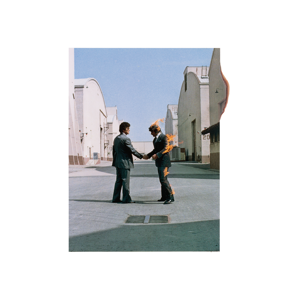The story itself is relatively easy to follow, despite the scribbled lyrics on the inner sleeves, but luckily the music makes up for any shortcomings. “In The Flesh?” blasts out with some of the heaviest rock they’d ever played, providing something of an overture. “The Thin Ice” sets up the main “Another Brick In The Wall” suite, lamenting the loss of Pink’s father and lambasting the educational system via a maddening disco beat. The side ends deceptively sweetly with a conversation with his “Mother”.
“Goodbye Blue Sky” reinforces the war theme over a sad acoustic backing. “Empty Spaces” practically stops before it starts, made more confusing by the extra lyrics (and a complete song) not included on the album. The band gets heavy on “Young Lust” (aka “Ooh I Need A Dirty Woman”) before the phone call that sets up the nightmarish mind movie of “One Of My Turns”. Pink’s remorse is displayed in the woefully dissonant “Don’t Leave Me Now”, giving way to the anger of the final “Another Brick” segment and the resignation in “Goodbye Cruel World”.
The wall now complete, side three takes place almost entirely inside Pink’s head with the TV on. “Hey You” and “Is There Anybody Out There?” reflect his immediate regret at shutting himself off, taking inventory in “Nobody Home”, which combines references to Syd Barrett with soundbites from Gomer Pyle. Perhaps that is supposed to set up the World War II sentiments of “Vera” and “Bring The Boys Back Home”; nonetheless they’re soon forgotten as “Comfortably Numb” brings him back to the present while Gilmour plays two masterful solos.
Having been more or less revived, Pink imagines the Beach Boys singing “The Show Must Go On” and he takes the stage “In The Flesh”, with alternate lyrics baiting the crowd whose chant of “Pink Floyd!” soon turns to “Hammer!” The ensuing riot supposedly takes place in “Run Like Hell”, but the lyrics don’t seem to add much to the plot. “Waiting For The Worms” continues the menace despite some doo-wop interludes, and then, apparently having had enough, Pink decides to “Stop”, subjecting himself to the degradation of “The Trial”. Colored like a Gilbert & Sullivan song, it expertly delivers the testimony of the schoolmaster, wife and mother before the judge gives his verdict over the “Another Brick” melody. And finally, the clarinets come in for life “Outside The Wall”, and the cycle begins anew.
The Wall soon became somewhat of a rite of passage for suburban white kids. Early adopters could knowingly wink at each other, watching when someone heard it for the first time then let it stay in constant rotation in their tape deck. After all, the first thing you hear on the album is the second part of the sentence that’s cut off at the end of the album—an endless cycle, a mobius loop, a Geordian knot, a dog chasing its tail. Images from the film also play into one’s perspective when the songs go by, which isn’t always a good thing.
 The tour, which was so huge it could only visit five cities, was perhaps a better presentation of the story, and was finally represented by a live album two decades later. Is There Anybody Out There? combined music from two London shows recorded ten months apart, which included extra music in “What Shall We Do Now?”, discarded from side two, and “The Last Few Bricks”, a suite designed to kill time while the stagehands finished stacking the objects of the title into place, obscuring the band completely. This would be better experienced visually, of course, yet to date no footage of the shows has been released.
The tour, which was so huge it could only visit five cities, was perhaps a better presentation of the story, and was finally represented by a live album two decades later. Is There Anybody Out There? combined music from two London shows recorded ten months apart, which included extra music in “What Shall We Do Now?”, discarded from side two, and “The Last Few Bricks”, a suite designed to kill time while the stagehands finished stacking the objects of the title into place, obscuring the band completely. This would be better experienced visually, of course, yet to date no footage of the shows has been released.
Still, it’s something of a testament to the writers that despite the content, a handful of the tracks became so popular on Classic Rock radio, and no coincidence that most of those were sung by David Gilmour. In the end, The Wall is something one grows out of, but could lead you to pick up the rest of their albums, and therefore discover some less obvious treasure.
When the catalog was revamped for a new decade, The Wall got the deluxe treatment alongside Dark Side and Wish You Were Here. The Experience Edition got a disc of demos, but the Immersion Edition went all out with two discs of demos, plus the Is There Anybody Out There set and a DVD including a documentary. The demos themselves show how far Roger was from the final presentation before others helped him put it all into shape. A few alternate band recordings, such as what would turn into “Young Lust” and “Comfortably Numb”, as well as tracks from The Final Cut and Roger’s eventual solo debut, are fascinating. The program ends, fittingly, with David’s instrumental sketches for “Comfortably Numb” and “Run Like Hell”. After all, Roger couldn’t have done it without him.
Pink Floyd The Wall (1979)—4
2012 Experience Edition: same as 1979, plus 27 extra tracks
2012 Immersion Edition: same as Experience, plus 67 extra tracks and DVD
Pink Floyd Is There Anybody Out There? The Wall Live 1980–81 (2000)—3



















